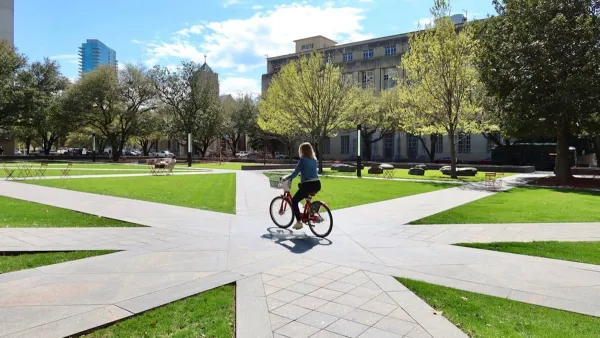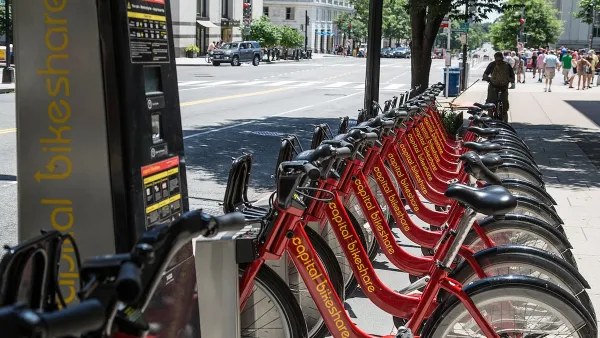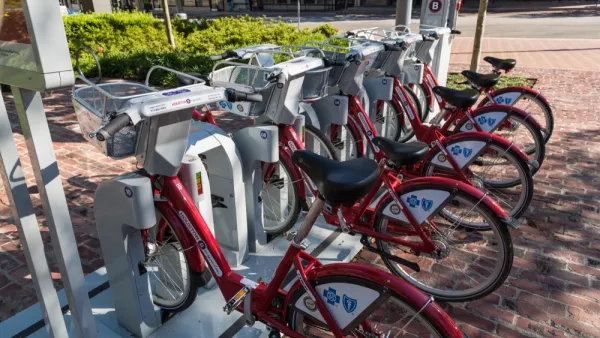The inherent simplicity of bikes makes shared mobility systems a crucial transportation option during natural disasters.

Writing for Bloomberg CityLab, John Surico praises the value of municipal bikeshare systems, which can provide a transportation lifeline during natural disasters or other crises. When Hurricane Ida flooded New York City’s subway system, Surico—and tens of thousands of other New Yorkers—turned to the Citi Bike bikeshare system to get around.
“The nation’s largest bikeshare system clocked 126,360 trips the day after Ida — then the highest in its eight-year history — as bike lanes swarmed with stranded passengers like me,” Surico writes, noting that this held true in other situations.
Citi Bike also broke records this summer during a brutal heat wave that kept subway stations sweltering. When Tube workers went on strike in London in June, Santander Cycles, the city’s bikeshare system, saw riders flocking to it. In Washington, D.C., the Metro’s 2016 repairs led to a 6% increase in ridership for Capital Bikeshare (or CaBi, for short).
The relative simplicity of bikes and bikeshare, Surico writes, “can be particularly useful when other modes are sidelined.” This is why Surico argues that city officials and transit agencies should pay more attention to bikes and the needs of bike users and work to make bikeshare and transit systems complement and support each other.
Jascha Franklin-Hodge, the chief of streets for Boston, noted that the city’s Bluebike bikeshare system was a key alternative for Bostonians when the Orange Line shut down for repairs in August. The city made the system free during the shutdown to ease the transition for commuters. “If you don’t think of bikes as transportation, you will not do the things you need to do to make it a good alternative during a transportation crisis,” Franklin-Hodge said.
FULL STORY: In Times of Crisis, Bikeshare Rolls On

National Parks Layoffs Will Cause Communities to Lose Billions
Thousands of essential park workers were laid off this week, just before the busy spring break season.

Retro-silient?: America’s First “Eco-burb,” The Woodlands Turns 50
A master-planned community north of Houston offers lessons on green infrastructure and resilient design, but falls short of its founder’s lofty affordability and walkability goals.

Delivering for America Plan Will Downgrade Mail Service in at Least 49.5 Percent of Zip Codes
Republican and Democrat lawmakers criticize the plan for its disproportionate negative impact on rural communities.

Test News Post 1
This is a summary

Test News Headline 46
Test for the image on the front page.

Balancing Bombs and Butterflies: How the National Guard Protects a Rare Species
The National Guard at Fort Indiantown Gap uses GIS technology and land management strategies to balance military training with conservation efforts, ensuring the survival of the rare eastern regal fritillary butterfly.
Urban Design for Planners 1: Software Tools
This six-course series explores essential urban design concepts using open source software and equips planners with the tools they need to participate fully in the urban design process.
Planning for Universal Design
Learn the tools for implementing Universal Design in planning regulations.
EMC Planning Group, Inc.
Planetizen
Planetizen
Mpact (formerly Rail~Volution)
Great Falls Development Authority, Inc.
HUDs Office of Policy Development and Research
NYU Wagner Graduate School of Public Service





























